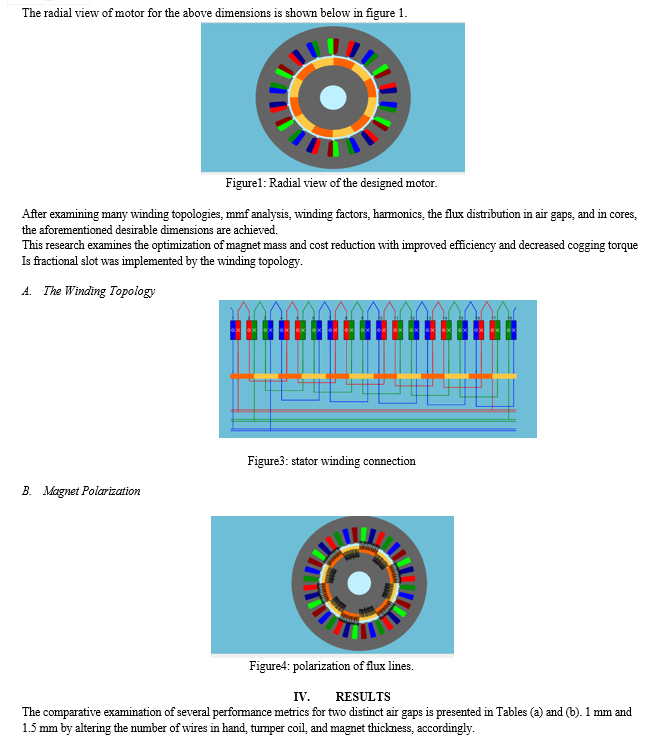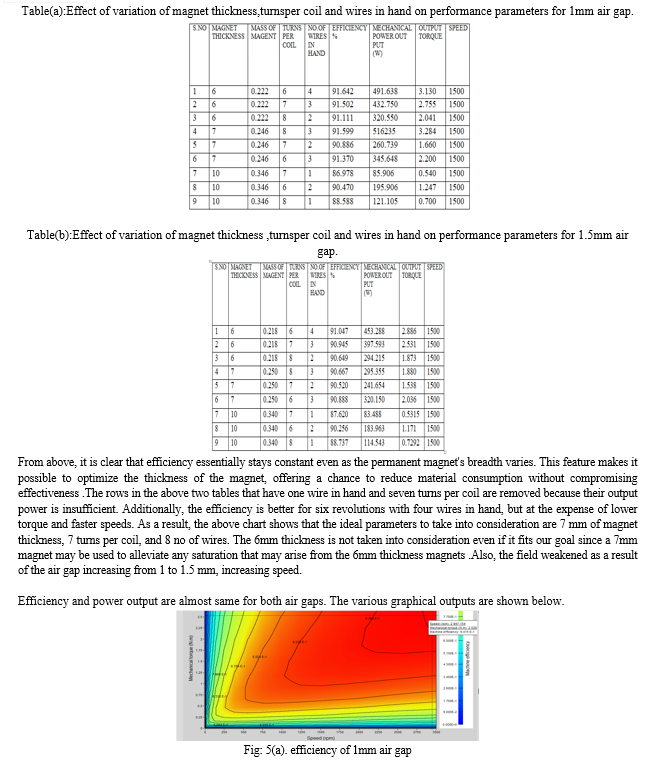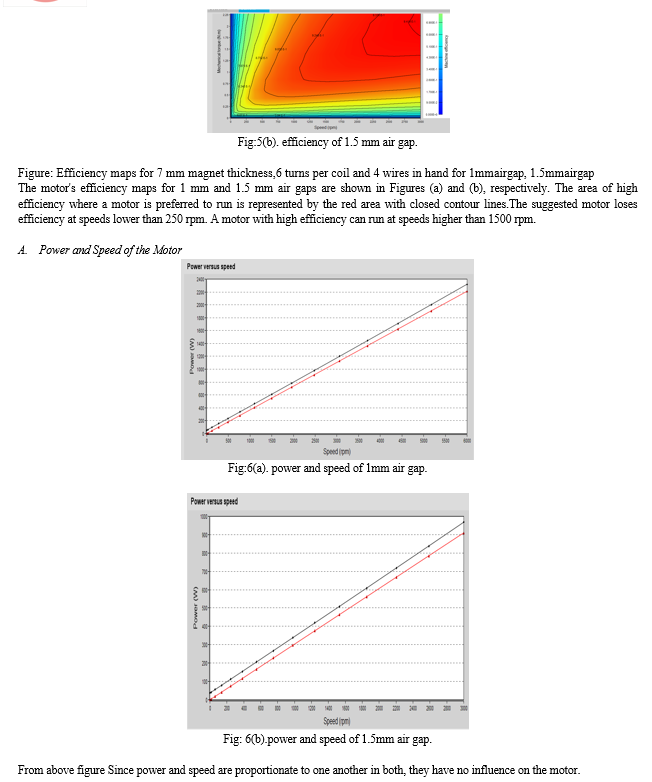Ijraset Journal For Research in Applied Science and Engineering Technology
- Home / Ijraset
- On This Page
- Abstract
- Introduction
- Conclusion
- References
- Copyright
Design of Radial Flux PM Synchronous Motor for EV Applications
Authors: Marapally Sai Charan, Umakanta Choudhury
DOI Link: https://doi.org/10.22214/ijraset.2024.63668
Certificate: View Certificate
Abstract
High-performance electric propulsion systems are becoming increasingly important as the automotive industry rapidly shifts to electric cars (EVs). The electric motor is an essential part of these systems as it determines the power, efficiency, and overall performance of the vehicle.This project uses Altair Flux, a full-featured finite element analysis (FEA) software suite, to build and optimize a radial flux motor (RFM) with permanent magnet synchronous motor (pmsm) . The main goal is to increase the power density and efficiency of the electric propulsion system for electric cars by utilizing Altair Flux\'s simulation and analytical capabilities. The purpose of this project is to showcase the design and optimization capabilities of electric vehicle propulsion systems, with a focus on Radial Flux P.M Synchronous Motors. One of the crucial areas that has to be addressed in order to maintain high efficiency and decrease overall costs is reducing the quantity of magnet material used. measuring the motor at various frequencies and obtaining the characteristics of speed versus torque It attempts to create an RFM that satisfies the stringent criteria of EV applications in terms of efficiency, power density, and reliability by thorough simulation and analysis. The study\'s findings may help the automobile sector embrace electric vehicles more widely and provide environmentally friendly transportation options.
Introduction
I. INTRODUCTION
The need for personal mobility and the growing worldwide population have resulted in a sharp rise in the demand for oil, which has caused emissions and contributed to global warming. One idea to help with the energy issue and lower greenhouse gas emissions is to employ electric vehicles that run on batteries. Air quality and the environment as a whole are deteriorated by the emissions from internal combustion engines, which include sulfur dioxide (SO2), hydrocarbons (HC), particulate matter (PM), carbon dioxide (CO2), carbon monoxide (CO), nitrogen oxides (NOx), and particulate matter (PM).
One of the main greenhouse gases causing climate change is carbon dioxide, which traps heat in the atmosphere and causes global warming. Because carbon monoxide prevents oxygen from entering the bloodstream, it immediately endangers people's health. Unlike conventional gasoline or diesel cars, electric vehicles (EVs) are powered by rechargeable batteries and do not emit exhaust emissions.
EVs have the ability to improve air quality and mitigate climate change by reducing greenhouse gas emissions and air pollution by using electricity as a fuel source.
Electric cars can also aid in lowering reliance on fossil fuels. Clean and sustainable energy may power transportation with electricity as renewable energy sources like solar and wind power become more widely available. Several motor types are used to power electric cars, with the permanent magnet synchronous motor (PMSM) being one of the most often used varieties.
The PMSM offers several benefits over other kinds of motors, including being lightweight and efficient, which allows it to generate large amounts of power without consuming a lot of room or energy.
These motors aim to improve upon their current state, and one method to achieve this is by optimizing the size and placement of the magnets inside the motor. In this study, the effects of the magnets on the motor's performance—that is, its efficiency and energy consumption—were the focus of the investigation.
Overall, engine performance and energy efficiency may be increased by adjusting the magnets utilized in electric car motors.
Permanent magnet (PM) motors with radial flux have several benefits.
High torque: The radial design makes it possible for the magnetic field to interact with a bigger air gap between the stator and rotor. Because of the bigger air gap, the magnetic field has a stronger leverage point, which leads to a high torque output for the size of the motor.
The structure of this document is as follows: The literature review needed for the motor's design and different parameter analysis is provided in Section II. The Radial flux PMSM setup, modeling, and important design parameters are covered in Section III.
The comparison and analysis of the primary simulation results are shown in the first section of Section IV. The second section discusses the torque versus speed at various frequencies. The concluding remarks are included in Section V.
II. LITERATURE REVIEW
The PMSM, also known as the permanent magnet synchronous motor, is well-known for its straightforward design, dependable performance, compact size, light weight, low inertia and quick reaction, high power factor and high power density, high efficiency, and position as the preferred electric vehicle motor. The performance of the motor is also significantly impacted by modifications made to the permanent magnet (PM) structure of the PMSM rotor. PM structures are separated into surface and interior categories. Permanent magnets placed on the surface are often surface structures.[1].
Topology of motors. The permanent magnet synchronous motor's variable rotor construction allows it to adapt to the various performance structure needs of various electric cars, giving it a diversity of topology.
Permanent magnet synchronous motors come in two varieties, surface mount and embedded, depending on where the rotor magnet is positioned. The embedded kind is typically used in electric vehicles, as seen in the rotor construction of the Toyota Prius primary drive motor. [2]
The windings are turned on one at a time, creating a revolving magnetic field. When the stator is turned on, an electromagnetic force is generated, which attracts the magnets on the rotor. As a result, the rotor lines up with the electromagnetic poles of the stator. This alignment is the fundamental concept of Permanent Magnet Synchronous Motors (PMSM).The PMSM rotates according to the position of the rotor, which is established by a Hall Effect sensor inside the motor.
The sinusoidal back electromotive force (EMF) that the motor generates affects the torque that it produces.[3]
The authors of [4] explain how changes to the magnetic materials—such as NdFeB, Sm2Co3, and Sm2Co17—installed on the rotor impact efficiency. The different magnet materials have different magnetic flux densities, which affects the output coefficient and other metrics associated with it. Finally, it was shown that NdFeB magnets provide higher efficiency. The authors describe in [5–8] the design methodologies, standards, and optimization techniques that may be applied to enhance motor design and validate analytical computations utilizing finite element analysis.
Since there are enough charging stations in the big cities, EVs have become more and more popular in recent years. Likewise, an electric motor is used by EVs in place of internal combustion engines. The characteristics and constraints of the electric motors utilized to increase the EV's efficiency were examined in the study that was given.[9].
Nevertheless, there are several drawbacks to the dispersed winding motor and inside permanent magnet, including excessive temperature increase, poor efficiency at low speeds, and significant
torque ripple [10]. Thus, it is necessary to make certain structural adjustments in order to enhance the IVPM motor's operating performance.
III. RADIAL FLUX MOTOR DESIGN
The Ampere 390V vehicle's radial flux motor is chosen, and table I displays the RFPMM's operating parameters.
Table .1 OBTAINED DATA FROM RADIAL FLUX MOTOR
|
Electric quantities |
values |
|
Power (W) |
1045.5 |
|
Current (I) |
22.89 |
|
Voltage (V) |
390 |
|
Rated torque(N.m) |
3.152 |
|
Efficiency(%) |
91 |
|
speed |
1500 |
Measurements have been made of the radial flux motor's design dimensions, including its outer and inner diameters, the stator slot's height and width, the permanent magnet's length and breadth, etc. The stator of a conventional radial flux BLDC motor has a permanent magnet rotor.
A yoke attached to the stator is covered with individual electromagnetic coil-wrapped "teeth." As alternating magnetic poles, teeth function. Torque is produced by the interaction between the rotor's magnetic poles and the teeth's alternating magnetic flux. Here, however, an externally spinning radial flux motor has been used as the motor. In contrast to an embedded motor, the surface mount PM type under investigation is less expensive and has a simpler structure. Second, because surface mounted magnets are in direct contact with the rotor surface, they provide more efficient cooling systems and improve heat dissipation. As a consequence, the motor performs better thermally and is guaranteed to run within ideal temperature ranges, which is crucial for preserving longevity and efficiency. For Permanent Magnet Synchronous Motors (PMSMs) in Electric Vehicles (EVs), choosing the appropriate magnet material is essential to get the best possible performance and efficiency. Neodymium-based magnets—like neodymium-iron-boron (NdFeB)—are typically used because of their high magnetic strength, which enables smaller motor designs and better power densities. With their exceptional energy efficiency, these magnets allow electric vehicles to go farther between charges. Neodymium magnets also show good temperature stability, which guarantees steady performance even under a range of working circumstances. It is crucial to take into account the sustainability of these materials' supply chains and their influence on the environment.
Although they are more expensive, alternatives like samarium-cobalt (SmCo) magnets may be selected for situations where environmental concerns or improved temperature stability are important factors. NeFeB1370_1273 is therefore taken into consideration for investigational purposes due to its high saturation flux density.
Two fundamental characteristics of the stator and rotor core are the B-H curve and the iron losses. The fundamental construction of the motor can be constructed from laminated silicon material.
Lower iron losses are achieved using thinner laminated material, but at a higher cost. M350-50A laminated steel is employed in this study due to its low loss density and high saturation flux density.
The specifications and parameters required for the design of PMSM is given in Table and Table 3.
Table.2.PMSM’s Stator and Rotor core design parameters.
|
Quantity |
Value (mm) |
|
Rotor Outer diameter |
68 |
|
Rotor inner diameter |
20 |
|
Rotor poles |
12 |
|
length |
25 |
|
Stator outer diameter |
120 |
|
Stator inner diameter |
70 |
|
No of Stator slots |
36 |
The slot parameters are described intable2.
|
Quantity |
Value(mm) |
|
Slot height |
14.85 |
|
Slot width(bottom part) |
4.576 |
|
Intermediary height of the slot (upper part) |
1.144 |
|
Slot width (upper part) |
3.268 |
|
Height of the slot opening |
0.6537 |
|
Width of slot opening |
0.6537 |
The coil parameters are described in table 3.
|
parameter |
values |
|
No. of turns per coil |
6 |
|
No. wires in hand |
4 |
|
Wire diameter |
1.102mm |
|
Inter-wire space |
0.005mm |




Conclusion
The motor\'s efficiency, torque production, and flux distribution were examined in the simulation results under several operating circumstances, and changes in magnet thickness were also noted. As a consequence, the torque output of the radial flux pm synchronous motor has improved and magnetic losses have been reduced, which is encouraging. Furthermore, flux barriers efficiently guide the magnetic flux, enhancing rotor synchronism and increasing efficiency to 94.90% while operating at broad speeds. Hence, creating a radial flux PMSM that is tailored for high-performance electric machines with increased efficiency and decreased losses advances motor technology for a range of industrial uses. To confirm the simulation results and investigate more avenues for improving the motor\'s efficiency and performance, more study and development are required. Our knowledge of the parameters of motor performance was further enhanced by the examination into the effects of different air gap lengths. An increase in the air gap distance was found to significantly reduce cogging torque, even while changes in efficiency and other characteristics were somewhat steady across varied air gap configurations. The same suggested motor produced a higher-power motor with a faster speed that is appropriate for highway travel when the turns per coil and the number of wires were changed.
References
[1] 2022 2nd International Conference on Electrical Engineering and Control Science (IC2ECS) Research on Permanent Magnet Structure of Permanent Magnet Synchronous Motor for Electric Vehicle. [2] The Development Status and Trend of Permanent Magnet Synchronous Motor in the Electric Vehicle Industry Wang Guiyong College of Water Construction, Northwest A&F University, Yangling , Shaanxi, China. [3] Kong, M. Lin, and L. Jia, “A novel high power density permanent-magnet synchronous machine with wide speed range,” IEEE Transactions on Magnetics, vol.56, no.2,pp.1– 6, 2020 [4] Aung, Eighdi et al. “Design of Conventional Permanent Magnet Synchronous Motorusedin Electric Vehicle.”(2014)5. H. Msaddek, A. Mansouri, S. Brisset and H.Trabelsi,\"Design and optimization of PMSM with outer rotor for electric vehicle,\"2015 IEEE 12th International Multi-Conference on Systems, Signals & Devices (SSD15), Mahdia, Tunisia, 2015, pp.1-6,doi: 10.1109/SSD.2015.7348154. [5] Bdewi, Mustafa & Mohammed, Ahmed & Ali, Mohammed Moanes. (2022). In-wheel, outer rotor, permanent magnet synchronous motor design with improved torque density for electric vehicle applications. International Journal ofElectrical and Computer Engineering (IJECE). 12. 4820-4831. 10.11591/ijece.v12i5.pp4820-4831. [6] Sundaram, Maruthachalam & Anand, Mouttouvelou & Chelladurai, Jaganathan & Varunraj, Paramasivam & Smith, Sam & Sharma, Shubham & ElHajAssad, Mamdouh & Alayi, Reza. (2022). Design and FEM Analysis of High-Torque Power Density Permanent Magnet Synchronous Motor (PMSM) for Two-Wheeler E-Vehicle Applications. International Transactions on Electrical Energy Systems. 2022. 1-14. 10.1155/2022/1217250. [7] Aung, Eighdi et al. “Design of Conventional Permanent Magnet Synchronous Motorusedin Electric Vehicle.”(2014). [8] H.Msaddek,A.Mansouri,S.BrissetandH.Trabelsi,\"Design and optimization of PMSM with outer rotor for electric vehicle,\"2015 IEEE 12th International Multi-Conference on Systems, Signals & Devices (SSD15), Mahdia, Tunisia, 2015, pp.1-6,doi: 10.1109/SSD.2015.7348154. [9] Bdewi, Mustafa & Mohammed, Ahmed & Ali, Mohammed Moanes. (2022). In-wheel, outer rotor, permanent magnet synchronous motor design with improved torque density for electric vehicle applications. International Journal of Electrical and Computer Engineering (IJECE). 12. 4820-4831. 10.11591/ijece.v12i5.pp4820-4831. [10] Sundaram, Maruthachalam & Anand, Mouttouvelou & Chelladurai, Jaganathan & Varunraj, Paramasivam & Smith, Sam & Sharma, Shubham & ElHajAssad, Mamdouh & Alayi, Reza. (2022). Design and FEM Analysis of High-Torque Power Density Permanent Magnet Synchronous Motor (PMSM) for Two-Wheeler E-Vehicle Applications. International Transactions on Electrical Energy Systems. 2022. 1-14. 10.1155/2022/1217250. [11] 2023 Innovations in Power and Advanced Computing Technologies (i-PACT) 979-8-3503-2518-8/23/$31.00 ©2023 IEEE 1 Electric Motor Systems: Relative Study on Diverse Motors in the Electric Vehicles [12] M. Kamiya, Y. Kawase, T. Kosaka and N. Matsui, \"Temperature distribution analysis of permanent magnet in interior permanent magnet synchronous motor considering PWM carrier harmonics\", Proc. Int. Conf. Elect. Mach. Syst., pp. 2023-2027, Oct. 2007. [13] High power density multiple output permanent magnet alternator Mudhigollam, Uday Kumar; Choudhury, Umakanta;Hatua, Kamalesh IET Electric Power Applications, Volume 12, Year 2018, Pages 494-501 [14] 6. Non-Saliency of Interior Permanent Magnet Hybrid Excitation Machine Mudhigollam, Uday Kumar; Choudhury, Umakanta; Hatua, Kamalesh Proceedings of 2018 IEEE International Conference on Power Electronics, Drives and Energy Systems, PEDES 2018, Volume , Year 2018
Copyright
Copyright © 2024 Marapally Sai Charan, Umakanta Choudhury . This is an open access article distributed under the Creative Commons Attribution License, which permits unrestricted use, distribution, and reproduction in any medium, provided the original work is properly cited.

Download Paper
Paper Id : IJRASET63668
Publish Date : 2024-07-18
ISSN : 2321-9653
Publisher Name : IJRASET
DOI Link : Click Here
 Submit Paper Online
Submit Paper Online

